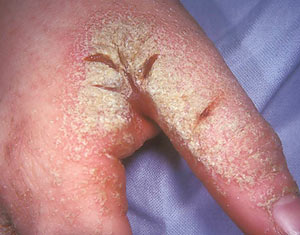A 10-year-old boy with a crusted area on hands
This 10-year-old boy noted a thickened crusted area of his hands that had been present for two months. He also had some eczematous dermatitis of his extremities and trunk. He and his mother had some itching although other household members had no symptoms.

What is your diagnosis? Click to the next page to find out.
Answer
This child has crusted scabies.
Scabies is an infestation with the mite Sarcoptes scabiei. The most consistent symptom of scabies is itching, especially at night. Affected individuals will have eczematous patches and papules particularly found in the finger web spaces, axillae, wrists, belt-line, and groin area.
![Patricia A. Treadwell, MD [photo]](/~/media/images/news/print/infectious-diseases-in-children/2008/03_march/treadwell_70_90_36311.jpg)
Patricia A. Treadwell, MD, is Professor in the Department of Pediatrics, Indiana University School of Medicine, Indianapolis.
A child contracts scabies through skin-to-skin contact with an infested individual. After several days to a few weeks, itching and an eczematous dermatitis develop.
The most diagnostic clinical finding is a scabetic burrow. The burrows are linear whitish lesions often found in the finger web spaces, sides of palms and soles, and on the scrotum in boys. Vesicular and nodular lesions may be seen in infants. A scabies variant, crusted scabies, is primarily seen in immunocompromised individuals. Keratotic thickening is present, particularly noted on the distal extremities. Fissures may develop in those flexural areas with thick crusting.
The diagnosis can be confirmed microscopically. Mineral oil is applied to the skin and a microscopic glass slide. A keratotic lesion, preferably a burrow, is scraped with a #15 scalpel blade and the contents are scraped onto the glass slide. The specimen is examined under low power to look for scabies mites.
The patient and all household members should be treated with permethrin cream 5%. The cream is applied from the neck down to every inch of the body. The patient and family are instructed to meticulously apply the cream to fold areas and scrape under the fingernails. The cream is left on overnight and washed off in the morning. Any clothing worn in the past three to four days, including bed linens, should be laundered in the morning. “Dry clean-only” clothing and stuffed animals are put in plastic bags for four to five days. The CDC states, “once away from the human body, mites do not survive more than 48 to 72 hours.” Oral ivermectin can be prescribed for immunocompromised patients, but this is an off-label use.
For more information:
- CDC website: www.cdc.gov/ncidod/dpd/parasites/scabies/factsht_scabies.htm
- Fox LM. Ivermectin: Uses and impact 20 years on. Curr Opin Infect Dis. 2006;19:588-593.
- Heukelbach J, et al. Scabies. Lancet. 2006;367: 1767-1774.
Spot the Rash is a monthly case study featured in Infectious Diseases in Children designed to test your skills in pediatric dermatology issues.



